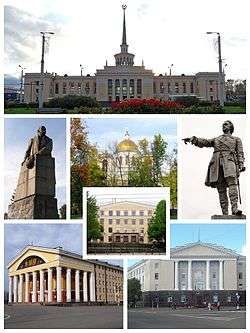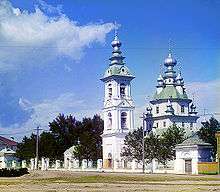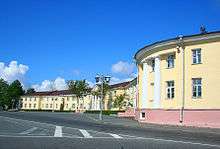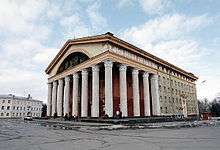Petrozavodsk
| Petrozavodsk (English) Петрозаводск (Russian) Petroskoi (Karelian) | |
|---|---|
| - City[1] - | |
 Views of Petrozavodsk | |
.svg.png) Location of the Republic of Karelia in Russia | |
 Petrozavodsk | |
|
| |
.png) |
|
|
| |
| City Day | Last Saturday of June |
| Administrative status (as of April 2013) | |
| Country | Russia |
| Federal subject | Republic of Karelia[2] |
| Administratively subordinated to | city of republic significance of Petrozavodsk[1] |
| Capital of | Republic of Karelia[1] |
| Administrative center of | city of republic significance of Petrozavodsk,[1] Prionezhsky District[1] |
| Municipal status (as of November 2011) | |
| Urban okrug | Petrozavodsky Urban Okrug[3] |
| Administrative center of | Petrozavodsky Urban Okrug,[3] Prionezhsky Municipal District[4] |
| Mayor | Galina Shirshina[5] |
| Representative body | City Council |
| Statistics | |
| Area | 135 km2 (52 sq mi)[6] |
| Population (2010 Census) | 261,987 inhabitants[7] |
| - Rank in 2010 | 71st |
| Density | 1,941/km2 (5,030/sq mi)[8] |
| Time zone | MSK (UTC+03:00)[9] |
| Founded | 1703 |
| City status since | March 21, 1777 |
| Previous names |
Petrovskaya Sloboda (until 1777), Petrozavodsk (until 1941), Äänislinna (until 1944) |
| Postal code(s)[10] | 185000–185003, 185005, 185007, 185009–185016, 185019, 185023, 185026, 185028, 185030–185035, 185700, 185890, 185899, 185910, 185960–185963, 185965, 185970, 185980–185983, 185985 |
| Dialing code(s) | +7 8142 |
|
| |
| Petrozavodsk on Wikimedia Commons | |
Petrozavodsk (Russian: Петрозаводск; IPA: [pʲɪtrəzɐˈvotsk]; Karelian/Vepsian/Finnish: Petroskoi) is the capital city of the Republic of Karelia, Russia, which stretches along the western shore of Lake Onega for some 27 kilometers (17 mi). Population: 261,987 (2010 Census);[7] 266,160 (2002 Census);[11] 269,485 (1989 Census).[12]
History
Archeological discoveries in the urban area indicate the presence of a settlement as far back as seven thousand years ago, and during the Middle Ages the site of modern city was marked by several lakeside villages. Within the city limits, the district of Solomennoje appears in surviving records dating back to the sixteenth century, and a map produced by the Flemish cartographer Abraham Ortelius at the end of that century places a settlement here called Onegaborg on the site of modern Petrozavodsk.[13]
On September 11, 1703, Prince Menshikov founded the settlement of Petrovskaya Sloboda ("Petrine Sloboda"). He did so at the behest of Tsar Peter the Great, who needed a new iron foundry to manufacture cannons and anchors for the Baltic Fleet at the time of the Great Northern War (1700–1721). At first the foundry used the name Shuysky zavod (literally, "factory at the Shuya River"), but a decade later it became Petrovsky zavod ("Petrine factory"), after the name of the reigning monarch. From this form the present name of the city derives.
By 1717, Petrovskaya Sloboda had grown into the largest settlement in Karelia, with about 3,500 inhabitants, a timber fort, a covered market, and miniature palaces of the Tsar and Menshikov. The town's best-known landmark became the wooden church of Saints Peter and Paul, rebuilt in 1772 and renovated in 1789. The church retained its original iconostasis until this relic of Peter's reign was destroyed by fire on October 30, 1924.
After Peter's death, Petrovskaya Sloboda became depopulated and the factory declined. It closed down in 1734, although foreign industrialists maintained copper factories in the vicinity.
The industry revived in 1773 when Catherine the Great established a new iron foundry upstream the Lososinka River. Designed to provide cannons for the ongoing Russo-Turkish Wars, the foundry was named Alexandrovsky, after Alexander Nevsky, who was considered a patron saint of the region. The factory was modernized and expanded under supervision of Charles Gascoigne in 1787–96. Local pundits claim that the first railway in the world (чугунный колесопровод) was inaugurated for industrial uses of the Alexandrovsky foundry in 1788.


During Catherine's municipal reform of 1777, Petrovskaya Sloboda was incorporated as a town, whereupon its name was changed to Petrozavodsk. A new Neoclassical city center was then built, focused on the newly planned Round Square. In 1784 Petrozavodsk was large enough to supplant Olonets as the administrative center of the region. Although Emperor Paul abolished Olonets Governorate, it was revived as a separate guberniya in 1801, with Petrozavodsk as its administrative center.
During the Finnish occupation of East Karelia in the Continuation War (1941–1944), the occupier chose to style the city Äänislinna (or Ääneslinna), rather than the traditional Petroskoi. The new name was a literal translation of Onegaborg, the name of a settlement marked on a 16th-century map by Abraham Ortelius near the present-day city, Ääninen being the Finnish toponym for Lake Onega.
The city was occupied by Finnish troops for nearly three years before it was retaken by Soviet forces on June 28, 1944. The Finns set up internment camps for civilians of Russian ethnicity which they operated until the Red Army liberated the area. Six camps were set up in Petrozavodsk, with 23,984 civilians of Russian ethnicity confined in them. Civilians of Finnish, Karelian or other Finnic descent were not interned into these camps. Some of the camps were old Soviet camps and some only fenced city areas.
In 1977, Petrozavodsk was the epicenter of what is called the Petrozavodsk phenomenon.
Administrative and municipal status
Petrozavodsk is the capital of the republic and, within the framework of administrative divisions, it also serves as the administrative center of Prionezhsky District,[1] even though it is not a part of it.[2] As an administrative division, it is incorporated separately as the city of republic significance of Petrozavodsk—an administrative unit with the status equal to that of the districts.[1] As a municipal division, the city of republic significance of Petrozavodsk is incorporated as Petrozavodsky Urban Okrug.[3]
Landmarks
Petrozavodsk is distinguished among other towns of North Russia by its Neoclassical architectural heritage, which includes the Round Square (1775, reconstructed in 1789 and 1839) and the Alexander Nevsky Cathedral (consecrated in 1832). Among the town's landmarks are the outdoor statues of Peter I (bronze and granite, Ippolit Monighetti, 1873), Gavrila Derzhavin (a Russian poet who was the governor of Olonets in the 18th century), and Alexander Nevsky (erected outside Alexander Nevsky Cathedral in 2010).
The city has a fine frontage on the Gulf of Petrozavodsk. The modern embankment, inaugurated in 1994, displays an assortment of Karelian granites and marbles. It is lined with extravagant postmodernist sculptures presented by sister cities of Petrozavodsk from around the world. There is also a birch copse, where the first church of Petrozavodsk was built in 1703.
Petrozavodsk is home to the Karelia Philharmonic Orchestra (1933), the Karelian Musical Theater (1955, statuary by Sergey Konenkov), National Library of Karelia (1959), Finnish-speaking National Theater of Karelia (1965), Petrozavodsk State University, a conservatory, a city museum founded in 1871, and a branch of the Russian Academy of Sciences.
One of the city's central landmarks is Lenin Square, an oval space with a large Soviet-era statue of Lenin in the center. The square is especially notable for English-speaking visitors because it is also called "round square" - a paradox in English, but not in Russian (kruglaya ploshad).
Suburbs

The village of Shoksha near Petrozavodsk contains a quarry of red and pink quartzite which was used in construction of Saint Isaac's Cathedral and Lenin Mausoleum, among many other notable structures. There are also other quarries in the region excavating road aggregates (Goloday Gora – gabbro-diabase) near Derevyanka.
The suburb of Martsialnye Vody is the oldest spa in Russia, founded by Peter the Great in 1714 and visited by the Tsar on four occasions. Its name means "The Waters of Mars" in Russian. Although Peter's palace at Martsialnye Vody has not survived, there is a museum devoted to the spa's history.
From Petrozavodsk harbor a hydrofoil service of "KareliaFlot" company carries people to the island of Kizhi, a World Heritage Site with an outdoor museum of ancient wooden architecture.
Transportation
The city is served by the Petrozavodsk Airport, and a train station on the Murmansk Railway with train connections to the main population centers of Russia.
An international tourist route Blue Highway goes through Petrozavodsk.
Climate
Under the Köppen climate classification, Petrozavodsk experiences a subarctic climate (Dfc), though unlike most localities with this type of climate there is no permafrost and relatively moderate temperatures thanks to the moderating influence of the Baltic Sea and the many nearby lakes. Winters, though long and cold, are mild for the high latitude, while summers are short and warm. Precipitation averages 611 millimetres or 24.06 inches annually.
| Climate data for Petrozavodsk | |||||||||||||
|---|---|---|---|---|---|---|---|---|---|---|---|---|---|
| Month | Jan | Feb | Mar | Apr | May | Jun | Jul | Aug | Sep | Oct | Nov | Dec | Year |
| Record high °C (°F) | 5.4 (41.7) |
7.3 (45.1) |
15.5 (59.9) |
24.2 (75.6) |
33.0 (91.4) |
31.9 (89.4) |
33.9 (93) |
32.4 (90.3) |
28.5 (83.3) |
21.3 (70.3) |
11.1 (52) |
9.4 (48.9) |
33.9 (93) |
| Average high °C (°F) | −6.4 (20.5) |
−5.9 (21.4) |
−0.3 (31.5) |
6.5 (43.7) |
13.6 (56.5) |
18.4 (65.1) |
21.5 (70.7) |
18.6 (65.5) |
13.1 (55.6) |
6.4 (43.5) |
−0.5 (31.1) |
−4.3 (24.3) |
6.7 (44.1) |
| Daily mean °C (°F) | −9.3 (15.3) |
−9.1 (15.6) |
−3.7 (25.3) |
2.3 (36.1) |
8.7 (47.7) |
13.7 (56.7) |
17.0 (62.6) |
14.5 (58.1) |
9.5 (49.1) |
3.8 (38.8) |
−2.8 (27) |
−7 (19) |
3.1 (37.6) |
| Average low °C (°F) | −12.6 (9.3) |
−12.3 (9.9) |
−7 (19) |
−1.6 (29.1) |
3.9 (39) |
9.0 (48.2) |
12.5 (54.5) |
10.7 (51.3) |
6.3 (43.3) |
1.4 (34.5) |
−5.2 (22.6) |
−9.9 (14.2) |
−0.4 (31.3) |
| Record low °C (°F) | −41.6 (−42.9) |
−39.3 (−38.7) |
−30 (−22) |
−19.3 (−2.7) |
−9.8 (14.4) |
−2.6 (27.3) |
−0.1 (31.8) |
−1.7 (28.9) |
−5 (23) |
−13.4 (7.9) |
−27.5 (−17.5) |
−36.8 (−34.2) |
−41.6 (−42.9) |
| Average precipitation mm (inches) | 36 (1.42) |
26 (1.02) |
32 (1.26) |
30 (1.18) |
48 (1.89) |
64 (2.52) |
82 (3.23) |
82 (3.23) |
60 (2.36) |
59 (2.32) |
50 (1.97) |
42 (1.65) |
611 (24.05) |
| Average snowfall cm (inches) | 25 (9.8) |
35 (13.8) |
38 (15) |
17 (6.7) |
6 (2.4) |
0 (0) |
0 (0) |
0 (0) |
0 (0) |
5 (2) |
11 (4.3) |
17 (6.7) |
154 (60.7) |
| Average rainy days | 4 | 4 | 6 | 11 | 16 | 18 | 18 | 18 | 20 | 19 | 11 | 6 | 151 |
| Average snowy days | 22 | 20 | 15 | 5 | 1 | 0 | 0 | 0 | 1 | 4 | 15 | 22 | 105 |
| Mean monthly sunshine hours | 27.9 | 70.0 | 117.8 | 177.0 | 263.5 | 282.0 | 288.3 | 217.0 | 126.0 | 65.1 | 24.0 | 9.3 | 1,667.9 |
| Source #1: Погода и Климат (Weather and Climate)[14] | |||||||||||||
| Source #2: [15] | |||||||||||||
Notable people
- Vladimir Drachev, biathlete
- Denis Zubko, association football player
- Sergey Katanandov, Head of the Republic of Karelia in 2002–2010
- Anastasia Maksimova, Rhythmic Gymnast
Twin towns and sister cities

Petrozavodsk is twinned with:
 Alytus, Lithuania
Alytus, Lithuania Brest, Belarus
Brest, Belarus Duluth, Minnesota, United States
Duluth, Minnesota, United States Joensuu, Finland
Joensuu, Finland La Rochelle, France, since 1973[16]
La Rochelle, France, since 1973[16] Narva, Estonia
Narva, Estonia Neustrelitz, Germany
Neustrelitz, Germany Neubrandenburg, Germany
Neubrandenburg, Germany Nyborg, Denmark
Nyborg, Denmark Ōhara, Chiba Prefecture, Japan
Ōhara, Chiba Prefecture, Japan Podolsk, Russia
Podolsk, Russia Portomaggiore, Italy
Portomaggiore, Italy Mo i Rana, Norway[17]
Mo i Rana, Norway[17] Telšiai, Lithuania
Telšiai, Lithuania Tübingen, Germany
Tübingen, Germany Umeå, Sweden
Umeå, Sweden Vagharshapat, Armenia
Vagharshapat, Armenia Varkaus, Finland
Varkaus, Finland
References
Notes
- 1 2 3 4 5 6 7 Law #871-ZRK
- 1 2 Constitution of the Republic of Karelia
- 1 2 3 Law #824-ZRK
- ↑ Law #825-ZRK
- ↑ Galina Shirshina: 'In our society there is a stereotype that a woman is soft', The Guardian, February 9, 2014
- ↑ Петрозаводск. Официальный сайт (in Russian). Archived from the original on August 23, 2011. Retrieved June 27, 2014.
- 1 2 Russian Federal State Statistics Service (2011). "Всероссийская перепись населения 2010 года. Том 1" [2010 All-Russian Population Census, vol. 1]. Всероссийская перепись населения 2010 года (2010 All-Russia Population Census) (in Russian). Federal State Statistics Service. Retrieved June 29, 2012.
- ↑ The value of density was calculated automatically by dividing the 2010 Census population by the area specified in the infobox. Please note that this value may not be accurate as the area specified in the infobox does not necessarily correspond to the area of the entity proper or is reported for the same year as the population.
- ↑ Правительство Российской Федерации. Федеральный закон №107-ФЗ от 3 июня 2011 г. «Об исчислении времени», в ред. Федерального закона №271-ФЗ от 03 июля 2016 г. «О внесении изменений в Федеральный закон "Об исчислении времени"». Вступил в силу по истечении шестидесяти дней после дня официального опубликования (6 августа 2011 г.). Опубликован: "Российская газета", №120, 6 июня 2011 г. (Government of the Russian Federation. Federal Law #107-FZ of June 31, 2011 On Calculating Time, as amended by the Federal Law #271-FZ of July 03, 2016 On Amending Federal Law "On Calculating Time". Effective as of after sixty days following the day of the official publication.).
- ↑ Почта России. Информационно-вычислительный центр ОАСУ РПО. (Russian Post). Поиск объектов почтовой связи (Postal Objects Search) (Russian)
- ↑ Russian Federal State Statistics Service (May 21, 2004). "Численность населения России, субъектов Российской Федерации в составе федеральных округов, районов, городских поселений, сельских населённых пунктов – районных центров и сельских населённых пунктов с населением 3 тысячи и более человек" [Population of Russia, Its Federal Districts, Federal Subjects, Districts, Urban Localities, Rural Localities—Administrative Centers, and Rural Localities with Population of Over 3,000] (XLS). Всероссийская перепись населения 2002 года [All-Russia Population Census of 2002] (in Russian). Retrieved August 9, 2014.
- ↑ Demoscope Weekly (1989). "Всесоюзная перепись населения 1989 г. Численность наличного населения союзных и автономных республик, автономных областей и округов, краёв, областей, районов, городских поселений и сёл-райцентров" [All Union Population Census of 1989: Present Population of Union and Autonomous Republics, Autonomous Oblasts and Okrugs, Krais, Oblasts, Districts, Urban Settlements, and Villages Serving as District Administrative Centers]. Всесоюзная перепись населения 1989 года [All-Union Population Census of 1989] (in Russian). Институт демографии Национального исследовательского университета: Высшая школа экономики [Institute of Demography at the National Research University: Higher School of Economics]. Retrieved August 9, 2014.
- ↑ http://dic.academic.ru/dic.nsf/enc_geo/3842/%D0%9F%D0%B5%D1%82%D1%80%D0%BE%D0%B7%D0%B0%D0%B2%D0%BE%D0%B4%D1%81%D0%BA
- ↑ "Pogoda.ru.net (Weather and Climate-The Climate of Petrozavodsk)" (in Russian). Weather and Climate. Retrieved 2014-08-19.
- ↑ HKO "Climatological Information for Cita, Russia." Hong Kong Observatory
- ↑ "La Rochelle: Twin towns". www.ville-larochelle.fr. Retrieved November 7, 2009.
- ↑ Petrozavodsk City Administration. Official website
Sources
- Верховный Совет Карельской АССР. №473-ЗРК 30 мая 1978 г. «Конституция Республики Карелия», в ред. Закона №1314-ЗРК от 16 июля 2009 г «О внесении изменений в Конституцию Республики Карелия». Опубликован: отдельной брошюрой. (Supreme Soviet of the Karelian ASSR. #473-ZRK May 30, 1978 Constitution of the Republic of Karelia, as amended by the Law #1314-ZRK of July 16, 2009 On Amending the Constitution of the Republic of Karelia. ).
- Законодательное Собрание Республики Карелия. Закон №871-ЗРК от 29 апреля 2005 г. «Об административно-территориальном устройстве Республики Карелия», в ред. Закона №1895-ЗРK от 2 июня 2015 г. «О внесении изменения статью 9 Закона Республики Карелия "Об административно-территориальном устройстве Республики Карелия"». Вступил в силу со дня официального опубликования. Опубликован: газета "Карелия", №48, 7 мая 2005 г. (Legislative Assembly of the Republic of Karelia. Law #871-ZRK of April 29, 2005 On the Administrative-Territorial Structure of the Republic of Karelia, as amended by the Law #1895-ZRK of June 2, 2015 On Amending Article 9 of the Law of the Republic of Karelia "On the Administrative-Territorial Structure of the Republic of Karelia". Effective as of the official publication date.).
- Законодательное Собрание Республики Карелия. Закон №824-ЗРК от 1 декабря 2004 г. «О наделении городских поселений статусом городского округа», в ред. Закона №1548-ЗРK от 3 ноября 2011 г «О внесении изменения в статью 2 Закона Республики Карелия "О наделении городских поселений статусом городского округа"». Вступил в силу по истечении десяти дней со дня официального опубликования. Опубликован: газета "Карелия", №139, 9 декабря 2004 г. (Legislative Assembly of the Republic of Karelia. Law #824-ZRK of December 1, 2004 On Granting Urban Okrug Status to Urban Settlements, as amended by the Law #1548-ZRK of November 3, 2011 On Amending Article 2 of the Law of the Republic of Karelia "On Granting Urban Okrug Status to Urban Settlements". Effective as of the day which is ten days after the day of the official publication.).
- Законодательное Собрание Республики Карелия. Закон №825-ЗРК от 1 декабря 2004 г. «О муниципальных районах в Республике Карелия», в ред. Закона №1694-ЗРK от 2 апреля 2013 г. «О преобразовании муниципальных образований "Нюхчинское сельское поселение" и "Сумпосадское сельское поселение" Беломорского муниципального района и внесении изменений в некоторые законодательные акты Республики Карелия». Вступил в силу по истечении десяти дней со дня официального опубликования. Опубликован: газета "Карелия", №141, 16 декабря 2004 г. (Legislative Assembly of the Republic of Karelia. Law #825-ZRK of December 1, 2004 On the Municipal Districts in the Republic of Karelia, as amended by the Law #1694-ZRK of April 2, 2013 On the Transformation of the Municipal Formations of "Nyukhchinskoye Rural Settlement" and "Sumposadskoye Rural Settlement" of Belomorsky Municipal District of the Republic of Karelia and on Amending Various Legislative Acts of the Republic of Karelia. Effective as of the day which is ten days after the day of the official publication.).
External links
| Wikivoyage has a travel guide for Petrozavodsk. |
- Official website of Petrozavodsk
- Official website of Petrozavodsk (Russian)
- Unofficial website of Petrozavodsk (Russian)
- Official website of the Board of Culture of Petrozavodsky Urban Okrug (Russian)
- Kizhi Museum